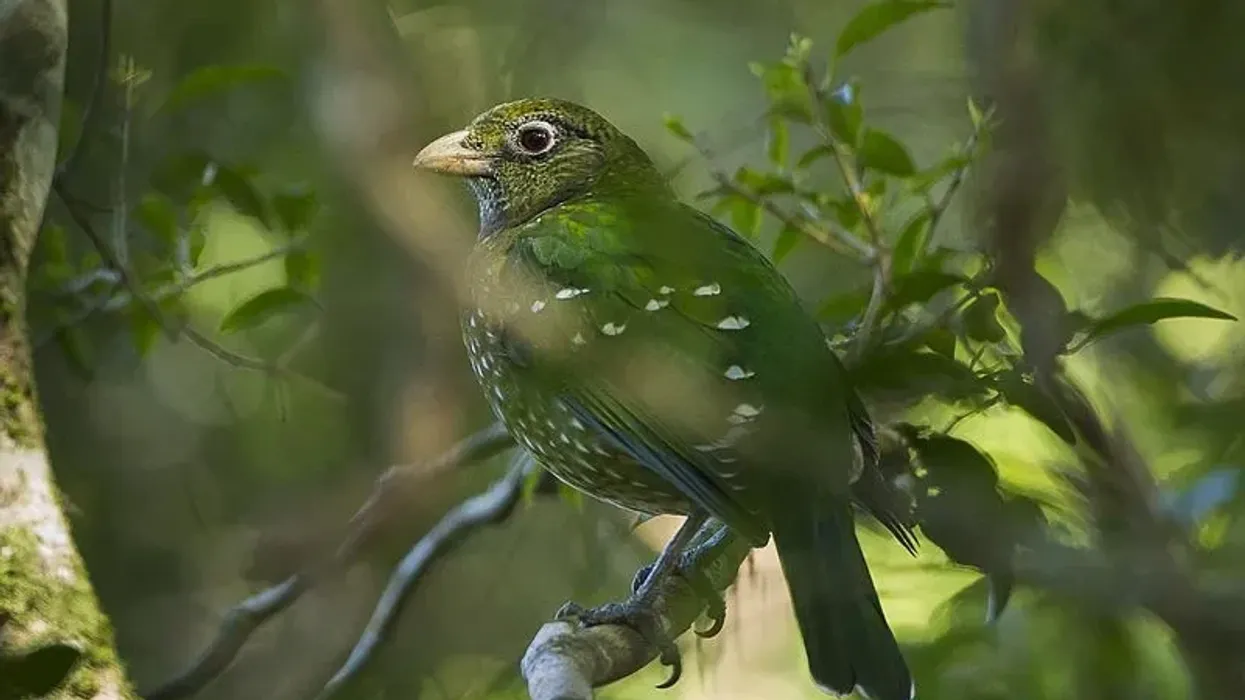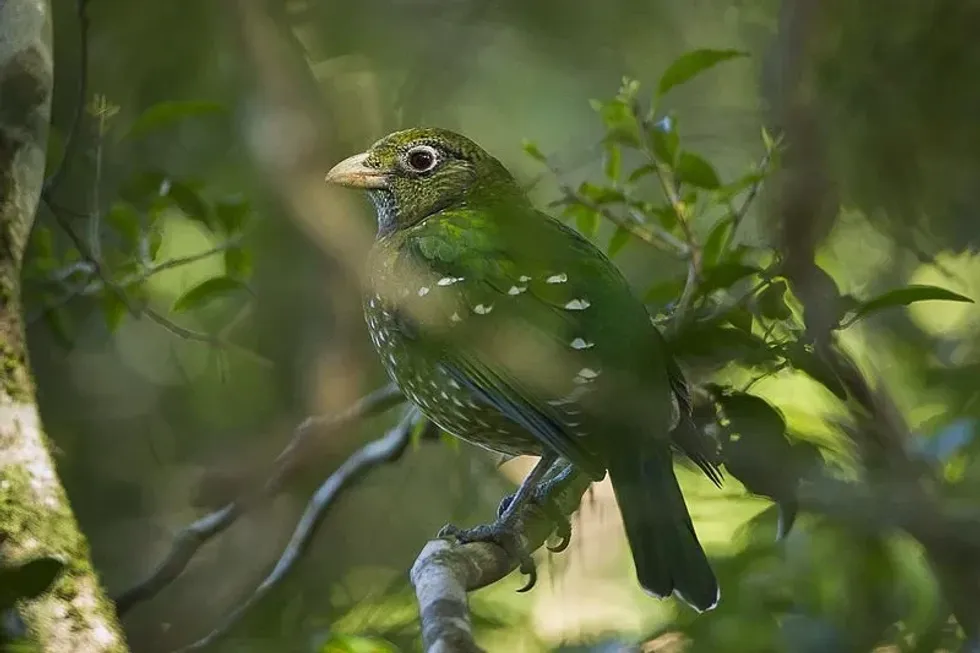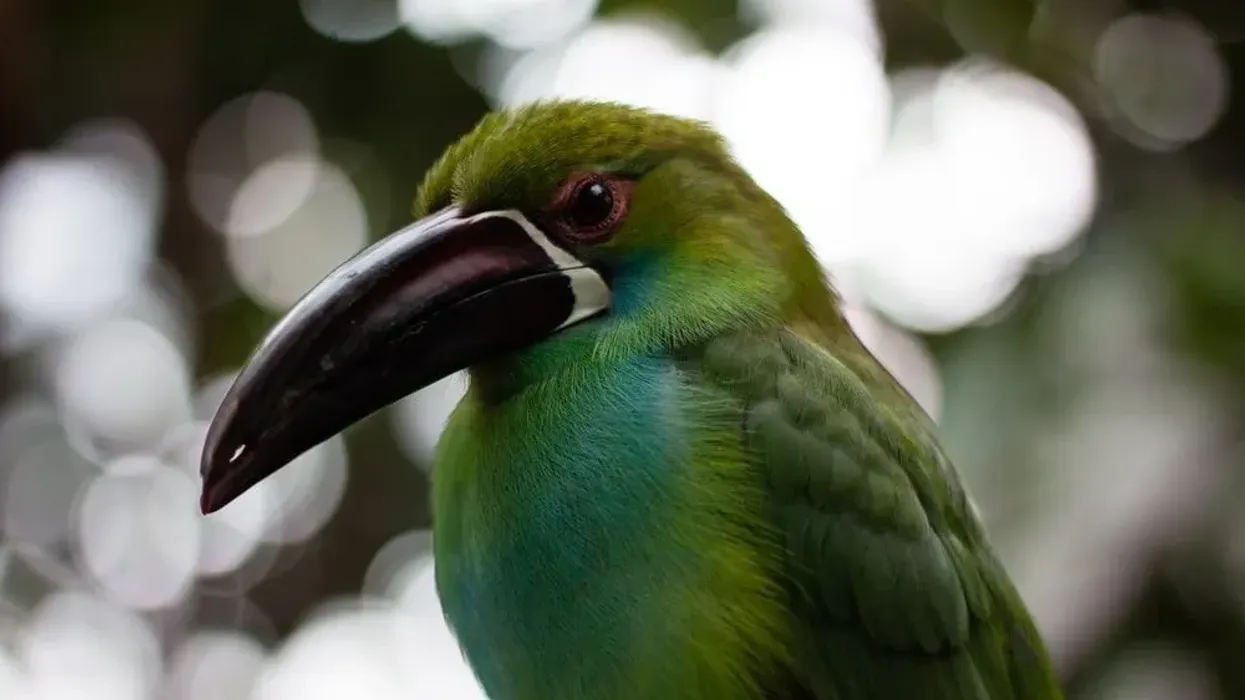The green catbird (Ailuroedus crassirostris) is a bowerbird of phylum Chordata, order Passeriformes, and family Ptilonorhynchidae. They are native to the subtropical zone of the east coast of Australia and New South Wales.
They are emerald green in color, have black markings on the face, and a large stout. They can be seen in southern New South Wales and Queensland.
This species has the majority of its population living in the temperate and sub-tropical rainforest and paperbarks, adjacent to the eucalypt forest. During the breeding season, they reduce their territorial size from 5 acres (2.02 ha) that has lots of fig trees which produce ripe fruit.
These birds really enjoy taking baths in water pools that are formed naturally in trees. Their feeding diet includes various insects like beetles, mites, and cicadas, but they also enjoy eating and living among fruit orchards.
Got an interest in birds and want to know about more of them? Here you can know some amazing facts about the black catbird and the catbird.
Green Catbird Interesting Facts
What type of animal is a green catbird?
The green catbird (Ailuroedus crassirostris), belonging to the east coast of Australia, is a medium-sized stocky bird with a greenish-brown head and has a call of a cat.
What class of animal does a green catbird belong to?
These species belong to the Aves class, order Passeriformes, genus Ailuroedus. Their scientific name is Ailuroedus crassirostris and they closely resemble the spotted catbird.
How many green catbirds are there in the world?
Green catbird population numbers are not currently known, their population trend is decreasing. However, their numbers have not touched the thresholds of Vulnerable species in the IUCN Red List. You can see them in southern New South Wales where they are very common.
Where does a green catbird live?
They are the bowerbirds of subtropical rainforests native to Australia. Their distribution is in the regions of the Cococla Coast in southeastern Queensland, where there is thick forest cover with good water availability and twigs and leaves to make their nest.
What is a green catbird's habitat?
The green catbird habitat consists of rainforests and these birds prefer habitats of greenery and easy water adaptability. They are found in paperbacks, eucalypt forests, scrublands, woodlands, farmlands, fruit orchards, and tall forests areas.
Who do green catbirds live with?
These species are both social creatures but also enjoy solitude. They socialize in small groups of three or five birds at the end of the breeding season and do not flock together other than the breeding season.
They can be seen in large groups of 20 birds feeding in the same territory during winter. They kill other small birds sometimes to feed their own young ones.
How long does a green catbird live?
The description of the exact lifespan of the green catbird species is not known yet, but the various observations have shown that green catbirds live for about eight years in the wild. In captivity, they have lived for 15 years.
How do they reproduce?
These bowerbirds are monogamous in nature and the male pairs up with the female to defend territory and feeding. The nest which they make uses twigs and leaves, prickly shrubs, and vines.
The nest also has a layer of wet softwood under the lining of dry leaves which gives the nest a large and bulky space. The breeding season of this catbird is from September to January.
What is their conservation status?
The conservation status of the green catbird (Ailuroedus crassirostris) according to the IUCN Red List by the International Union for Conservation of Nature (IUCN) is Least Concern. Though the range of its population is decreasing, the Red List has not mentioned this or placed this bird species under the Vulnerable status.
Green Catbird Fun Facts
What do green catbirds look like?
The Australian rainforest bird, the green catbird (Ailuroedus crassirostris), has a large stout white bill. The green catbird species has an interesting description because green catbirds have several black markings and white spots on the neck with a dusky crown.
They have very powerful wings that help them to tighten their grip on tree branches. The female and male look very similar but the juveniles resemble the female more. The young bird has a comparatively dull color on their bodies and their eyes are red.
How cute are they?
These green catbirds with white bills are Australian birds. The body markings of different shades of black and white gives them a beautiful appearance.
How do they communicate?
Green catbird behavior is typically solitary, and the male and female prefer to interact only with each other. The green catbird sound is somewhat the same as that of a cat 'meow-ing'. They use several vocalizations to contact their mates and they also use visual displays during courtship.
How big is a green catbird?
This bird, the green catbird (Ailuroedus crassirostris), is a small bird with a length of 9.4-12.9 in (24-33 cm). They weigh five times more than the weight of gray catbird of the same order Passeriformes.
How fast can a green catbird fly?
The Australian green catbird speed is not known, but their speed is somewhat similar to the related species of mockingbirds.
How much does a green catbird weigh?
The average green catbird adult size is around 4.2 oz (120 g).
What are the male and female names of the species?
Native to southern New South Wales, green catbirds do not have any specific names for males and females.
What would you call a baby green catbird?
Like the other birds of the same family, babies of green catbirds are called chicks or hatchlings.
What do they eat?
This bird is an omnivore and the green catbird diet consists of fruit, small flowers, seeds, grains from agricultural land, figs, small bees, wasps, millipedes, and other insects.
Are they dangerous?
This bird is not aggressive and appreciates the friendly efforts of humans towards them. They can attack if they feel in danger from anybody in order to protect their territory. They tend to show aggression towards the birds of other nests or green catbird predators.
Would they make a good pet?
These cute little birds are friendly towards humans. They are very shy and elusive at first but, when approached in the right way, they can get along with people very well. If you want to pet them, you need to create the right habitat for them as they are birds of temperate rainforests.
Did you know...
There is a folktale that if a green catbird visits you, it is often an indication that you are going to meet a more people than normal.
What is the green catbird's call?
The green catbird's call is like the crying of a human baby and they make sounds like whistles, whines, and nasal tones. Their song is called 'heer-I-aar.'
Why are they called catbirds?
The green catbird call sounds like the 'meow' of a cat with a shrilling tone, and they even sound like a human baby crying. From a distance, it can be confusing to figure out whether it is a cat or a bird.
Here at Kidadl, we have carefully created lots of interesting family-friendly animal facts for everyone to discover! For more relatable content, check out these gray catbird facts and mangrove mockingbird facts pages.
You can even occupy yourself at home by coloring in one of our free printable bowerbird coloring pages.









